For nearly two decades, the acrobatic tree swallow has been building feather nests in manmade boxes surrounding Red Slough WMA’s wetlands. Their delicate nests are fashioned from feathers gathered from the management area but are a relatively new addition to the region's bird life.
A single feather marks Nest Box # 21 as occupied; a simple but bold signal to other tree swallows at Red Slough Wildlife Management Area to keep moving.
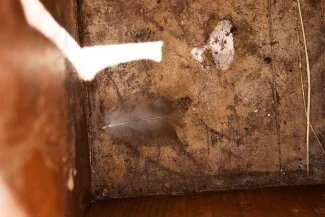
The newly paired tree swallows will gather a variety of feathers – primarily from egrets and ducks – to line the nest box. For the next five weeks the pair will guard their newly claimed territory, lay eggs, and search for insects to feed their growing chicks.
But these agile fliers haven’t always set up house in our state.
“When I first started working at Red Slough nearly 18 years ago, it was very uncommon for tree swallows to nest in Oklahoma,” said David Arbour, biological aid for the Wildlife Department.
Prior to 1979, when the first tree swallow nest was discovered at Cimarron County’s Lake Carl Etling, the birds were considered sporadic visitors to the state. Since then, the swallows have expanded their breeding territory southward into the eastern portion of Oklahoma.
Some biologists believe these neotropical migrants were first attracted to the state in the 1950s with the creation of large reservoirs. Permanently flooded trees began dying, creating additional habitat for birds that like to hide their nests in cavities of dead or dying branches or limbs. Regardless of their Oklahoma beginnings, tree swallows have been enticed to return each spring to Red Slough WMA in part by the nest boxes Arbour began installing on the area nearly two decades ago.
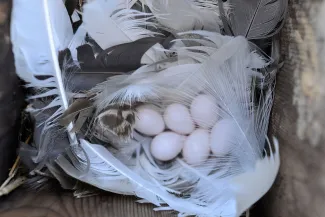
“We started putting up supplemental nest boxes for songbirds like prothonotary warblers and eastern bluebirds in 2000. A few years later, we found a tree swallow nest in one of our boxes,” said Arbour.
“I got the idea to put a few nest boxes over the water where the swallows prefer to nest. It worked and we now have about 30 pairs of nesting tree swallows at Red Slough.”
Arbour checks 30 nest boxes every other week during nesting season. At each nest box, he records if the nest is still under construction or monitors the number of eggs or the growth stage of chicks in completed nests. At least eight of the 30 nest boxes, a majority of which are located over open water, are currently occupied by tree swallows.
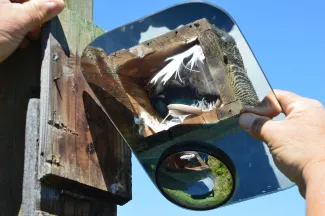
A few of the nest boxes have been installed with the lid of the box a little more than head high, so a mirror proves useful during nest checks.
Occasionally an incubating female will remain on the nest when Arbour lifts the nest box lid and peers at the reflection. “I just shut the lid and make a note that the female wouldn’t flush from the nest. I’ll find out how many eggs she has when I check the box in two weeks.”
“Tree swallows have fairly large broods. They’ll often lay five to six eggs.” Some of the nest boxes have been built with a wider base than the typical bluebird nest box to accommodate the high number of chicks. Even so, cavities are in such demand that tree swallows will use nearly any size box. The swallows will even compete for nest boxes already occupied by other songbirds.
At Nest Box #25, Arbour watched as a tree swallow chased a prothonotary warbler from the box. When the nest box lid was lifted, a single warbler egg, small and rust speckled, was lying on top of a moss-covered nest. “We will have to see which species wins out. If the tree swallow wins, they’ll just build a new feather nest right on top of the prothonotary warbler nest. One week it may be occupied by a warbler, two weeks later it may be occupied by a tree swallow.”
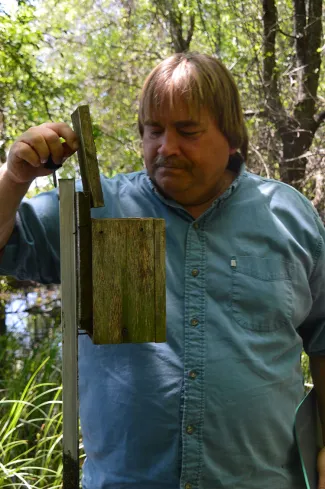
Though nests placed in cavities are typically safer than those open-cup nests built on a branch, Arbour is constantly looking for ways to protect the nest from predators.
“Raccoons and snakes are big problems for cavity nesting birds. I’ve removed several nest boxes from one of the levies because they were repeatedly being depredated by raccoons.”
While some nest boxes must be moved to another location to contend with predators, other boxes can remain in place with slight adjustments like installing entrance hole restrictors or removing small limbs from around the nest box. “I really don’t like to leave any branches overhanging the box. It’s too easy for a snake to climb out on the branch and enter the nest box.”
A More Traditional Nest
Tree swallows may dominate the nest boxes located near open wetlands, but more common cavity nesting birds like eastern bluebirds take advantage of four nest boxes in the WMA’s upland areas.
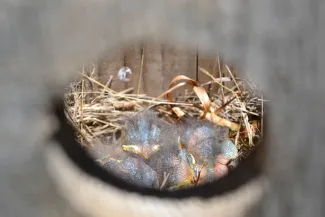
Three of the bluebird nests had already produced 14 fledged chicks by the second nest check in early May. These successful but currently empty nests are recorded as “spent nests.”
“If you’ll notice, there’s quite a bit of droppings from the bluebird chicks still inside the empty nests. That’s a good sign.” The chicks produce so many droppings in the last 24 hours before they fledge that the adults can’t keep up with the daily housekeeping requirements. “If the nest had been depredated before the chicks left the nest, there wouldn’t be as many droppings left behind.”
When Arbour checked the final nest box of the day, he found a “very spent, very poopy” nest. Five small eastern bluebird chicks had been present two week prior. “The adults will come right back to this nest box and lay more eggs.”
As long as birds are hiding their nests inside the boxes, Arbour will continue making his rounds, tracking which birds have set up house and how many chicks are growing inside.
Start Your Own Nest Box Program
One easy way to help cavity nesting songbirds in your area is to hang a nest box. Get construction plans from the Noble Research Institute.